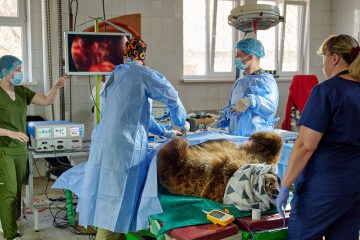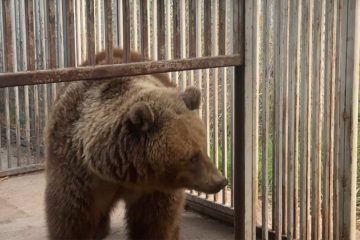Brown bear (Ursus arctos): problems of conservation and studying of population in Ukraine: monography / scientific editors: Ihor Dykyy, Maryna Shkvyria. – Kyiv: PLC “SIC Group Ukraine”, 2015. – 135 p.
ISBN 978-617-7092-57-4
The authors of the chapters:
I. Dykyy, M. Shkvyria, P. Khoetcky, I. Delehan, I. Skilsky, A.-T. Bashta, Ye. Ulyura, Ye. Yakovlev, C. Bautista-Leon, G. Gavrys, M. Luschak, N. Koval, L. Potish
Resume:
The brown bear population in Ukraine has undergone significant changes in its characteristics over the last century. The type of management, the condition of forests, the level of recreational activity the frequency of illegal hunting, etc., changed. The inclusion of the species in the Red Book of Ukraine did not save the bear from the negative population trend. Therefore, the issue of population management at the state level becomes extremely relevant. However, such programs must be based on sound research. During the years of independence, there were few such studies. So, over the past 15 years, the authors have intensified the collection of field data and attempted to analyze the state of the population. The main problems of conservation of the species in Ukraine have been updated. The collective monograph focuses on the history of brown bear research in Ukraine. An analysis of the patterns of population dynamics is given. A significant array of field data collected as part of research into the current state of the population, including the nature of distribution, number and sex-age structure, and ecological features, is also highlighted. The effectiveness of accounting methods is analyzed. The problems of the human-bear relationship are considered, including the conflict in the territories where the species lives, keeping the species in captivity, and the possibility of forming a positive image of the species. Particular attention is paid to the aspects of population management, primarily to the problems of organizing monitoring and protecting the brown bear population in Ukraine. Conclusions were made regarding the possibilities of extrapolation of foreign experience to the territory of Ukraine.
The main goal of the publication is to generalize the available modern disparate data on the ecology of the species and update the issue of preserving the population of the species in Ukraine.
For employees of scientific institutions, teachers and students of natural sciences of higher educational institutions, biology teachers of secondary schools, ecologists and local historians.
Please note, that the book is in Ukrainian, but English abstracts for all chapters are presented.

